#zimmer children's museum
Explore tagged Tumblr posts
Text


Katharine McPhee arriving for the 16th Annual Zimmer Children's Museum Discovery Award Dinner at the Skirball Cultural Center on November 15, 2016 in Los Angeles, California.
#katharine mcphee#arts and entertainment#zimmer children's museum#awards dinner#celebrities#california#los angeles#singer#actress#skirball cultural center#arrivals#charity event
41 notes
·
View notes
Text
'Think about Sylvester Stallone training as Rocky while the empowering theme song building him up. The montage is an editing technique you have seen before, in many different ways, like Rocky reaching those museum steps. It might be emotional, the passage of time can be rapid, and there might be new reveals. You have probably seen this technique in the movies by director Christopher Nolan, which dive into the spectacle of the story and emotional cores of the characters. A dream thief struggles with fantasy and reality. A dark knight never loses his heroism. The thoughts of doomsday torture a physicist. Editors Lee Smith and Jennifer Lame worked on these titles to create an ending with a potent impact before the screen goes to black. While not all of Nolan’s movies end this way, he seems to love a good montage to bring everything full circle.
'Inception' and 'Interstellar' Expand Their Worlds in Different Ways
“Come back to reality,” Professor Miles (Michael Caine) says for an important line in Inception (2010), where not everyone knows what is real or fantasy. The professor tells this to Dom (Leonardo DiCaprio), an expert thief who can invade a target’s dreams. The loss of his wife Mal (Marion Cotillard) has turned him into a haunted man. He deeply regrets his part in her death, but one mission could allow him to return to his children. That is if Dom doesn't cause his own downfall. He constantly rushes to use his totem, waiting for the spinning top to topple over, which will assure him he’s out of a dream. Many of the memories Dom retreats to in his mind are of his late wife, but there is also the final moment he sees his kids. And after Dom successfully completes the central mission, Hans Zimmer’s score intensifies on the journey home.
There is hardly any dialogue in this montage ending. The pacing and transitions are smooth and quick, almost dream-like, as Dom gets closer. Then the music slows. Dom doesn’t look to his spinning top, instead he hurries to his family when he gets the chance. His memories and life have been seen throughout the movie, and this, his most personal experience, isn’t meant for us. The camera pans away to the spinning top, which is about to fall. Mal was “possessed by an idea,” Dom explained at one point, this last shot of the spinning top is just as captivating. Nolan clarified what the ending means, in his own way, “There is a nihilistic view of that ending, right? But also, he’s moved on and is with his kids. The ambiguity is not an emotional ambiguity. It’s an intellectual one for the audience.” Dom’s totem and his children are part of Inception’s conflict of fantasy and reality, and this is what the montage lingers on. In Nolan’s other sci-fi epic, he goes bigger than slipping into someone’s subconscious.
The universe to Interstellar (2014) is endless. Cooper (Matthew McConaughey), Dr. Brand (Anne Hathaway), and the Endurance crew travel through a black hole to hostile planets in distant galaxies. They hope one will be the new home for the endangered human population. At various moments, there is cross-cutting, one method to limit how far Cooper is from his daughter Murph (Jessica Chastain). In a last ditch effort to save many lives, Cooper leaves Brand to travel to the next planet, allowing himself to be taken into the black hole. But it spits him out into a strange new setting where Cooper communicates with Murph across the previous years. Murph uses the data he sends over to save him and the world. For the existential crisis that erupts on Cooper’s space odyssey, the story narrows down to a child and parent finding each other again.
Cooper is finally reunited with Murph (Ellen Burstyn), now decades older than himself. She weeps, but takes comfort in seeing him, knowing it would happen. And why? “Because my dad promised me.” She doesn’t want him to see her imminent death, so she sends him to go find Brand. The ending closes in on both Cooper and Brand, separated by galaxies, but he’s been faced with greater obstacles. The montage has Cooper get into a spacecraft, while Brand sets up camp on a planet that will be suitable for life. It’s a new beginning, and Murph’s narration works as a closing statement: “Maybe, right now, she’s settling in for the long nap, by the light of our new sun, in our new home.” These final moments are hopeful. However, in Nolan’s superhero movies, it gets more complicated.
Gotham City Perseveres Because of the Batman
The Dark Knight (2008) challenges Bruce Wayne (Christian Bale) like never before with the chaos of the Joker (Heath Ledger). When it seems this villain is defeated, the Joker cackles, “You didn't think I'd risk losing the battle for Gotham's soul in a fistfight with you?” Another force of chaos is unleashed in the grieving, half-burned Harvey Dent (Aaron Eckhart), who has been manipulated terribly. Gotham’s white knight has sent crime lords and mobsters into prison, cleaning up the streets, but by the end, Dent wants revenge over who he blames for the murder of Rachel (Maggie Gyllenhaal), including a loved one of Commissioner Gordon (Gary Oldman). Dent is killed when Batman intervenes and the linear timeline is made flexible during the movie’s closing moments.
Batman isn’t a white knight, he can be blamed for Dent’s actions. In the montage sequence, Gordon gives a eulogy on Dent, then smashes the Bat Signal at a later time. For the greater good, the public will believe the cover-up. Can Batman die a hero, or will he live long enough to see himself become a villain? It seems Batman will be a villain to Gotham. But in The Dark Knight Rises (2012), the nocturnal crusader figures out how to avoid both of these scenarios. What helps is the emotional core to this trilogy in the relationship between Alfred (Michael Caine) and Bruce.
Alfred explains how he would take a trip to Florence, and visit a café where, “I had this fantasy that I would look across the tables and I’d see you there, with a wife, maybe a couple of kids. You wouldn’t say anything to me, nor me to you. But we’d both know that you made it. That you were happy.” That doesn’t seem to be the ending for Rises when Gotham is trapped under a nuclear bomb’s countdown. Batman is able to secure it to the Bat Wing, flying it safely out of the city, without any way he could survive the ensuing explosion. Bruce and Batman are soon memorialized, where Wayne Manor gets turned into an orphanage and a statue is built in honor of the dark knight. They die as heroes, or so it seems.
It’s in the title, the whole movie is about rising. There is the chant, “Deshi Basara!” that echoes in a prison pit, translated to, “Rise.” There is Bruce’s return into the bat armor, then his second return after his back is broken. Gordon delivers another eulogy, this time for Bruce, stating, “I see a beautiful city and a brilliant people rising from this abyss.” The ending makes good on all these motifs. Alfred goes to the café he mentioned and there he sees Bruce, alive and content. A booming score swells during the final scene, where Officer Blake (Joseph Gordon-Levitt) is lifted in the Bat Cave to become a new protector. For this brisk epilogue, Bruce gets his happy ending, while Gotham remains in safe hands. When Nolan makes movies based on real-life, the montage reflects on the horrors that have been seen.
Christopher Nolan’s Historical Thrillers Face the Future
Dunkirk (2017) pays off from previous scenes for a somber conclusion. On the civilian side of the story, George (Barry Keoghan) jumps onboard Mr. Dawson’s (Mark Rylance) boat, hoping to do something big with his life. The plan is to save the lives of stranded English soldiers. An accident from a traumatized soldier (Cillian Murphy) causes George to fall and suffer a severe head wound. Laying nearly motionless, he confides to Mr. Dawson’s son Peter (Tom Glynn-Carney) his hopes of being in the newspaper where his father and old teachers see him credited him as a hero. He ultimately dies, not surviving long enough for the rescue of soldiers from a disaster. George’s death doesn’t seem courageous in any way until the ending.
During the final scenes, Peter gets George’s picture and obituary into the paper, where he is hailed as the hero the young man wished to be. This cross-cuts with other scenes with active soldiers. Alex (Harry Styles) makes Tommy (Fionn Whitehead) read the paper, unable to meet the eyes of people outside their arriving train. They aren’t viewed as cowards like Alex fears, they are victors, having survived is enough. Out on the beach they were rescued from, infantry helmets lay out on the sand, although many were saved, many others died. Spitfire pilot Farrier (Tom Hardy) is taken captive, but after he burns his plane to destroy it from getting into the enemy’s hands. Out of all these moments, the strongest element goes to poor George. He is a hero for stepping onto Dawson’s boat and for having to deal with the consequences of war. In the case of Nolan’s other historical movie, a darker resolution is reached.
Oppenheimer (2023), at three hours long, is laced with doom. Cillian Murphy’s portrayal of J. Robert Oppenheimer is a man who can’t articulate his anxieties, or if he does, he’s ridiculed for it. At the start, he’s fascinated with the quantum world. Once he conquers the atomic bomb, these visions turn against him. The physicist soon fears that his creation will destroy everything one day. In a fantasy, he’s stuck in a fighter jet watching nuclear destruction. In another, he sees the world catch on fire when the atmosphere ignites. A major scene takes place between Oppenheimer and Albert Einstein (Tom Conti), but the audience can't hear what is being said at first, just like the lurking form of Lewis Strauss (Robert Downey Jr.). It’s this exchange that concludes the story.
“When I came to you with those calculations,” Oppenheimer tells Einstein, “we thought we might start a chain reaction that might destroy the entire world.” Einstein nods, recalling this, “I remember it well. What of it?” Murphy’s face is frozen, an expression that shifts depending on who might be watching, it could be of shock, horror, or a grim acceptance for what he’s done. “I believe we did,” Oppenheimer replies. In his head, nuclear missiles are fired into the sky and the atmosphere lights up, this time from global nuclear weaponry. The ending is no longer the physicist’s nightmares, but a plausible, current threat which the movie’s own audience will have to deal with.
Inception, Dunkirk, and the other movies have a runtime that is over two hours long. The ending needs to finish strong. Swift cuts keep the pacing from feeling lethargic. Repetition in visuals can bring a new meaning to what has been seen or said earlier. The energy to these montage endings can lift you up, or it can stick with you for a feeling that innocence has been lost. Either way in a Christopher Nolan movie, there is no going back.'
#Oppenheimer#Christopher Nolan#Inception#Dunkirk#Interstellar#Lee Smith#Jennifer Lame#Michael Caine#Cobb#Leonardo DiCaprio#Marion Cotillard#Hans Zimmer#Rocky#Anne Hathaway#Matthew McConaughey#Christian Bale#Heath Ledger#The Joker#Jessica Chastain#Ellen Burstyn#The Dark Knight#Aaron Eckhart#Joseph Gordon-Levitt#Maggie Gyllenhaal#Gary Oldman#The Dark Knight Rises#Mark Rylance#Barry Keoghan#Tom Glynn-Carney#Cillian Murphy
3 notes
·
View notes
Text

Zimmer Children's Museum Discovery Award Dinner at The Globe Theatre in Universal City, California - November 12, 2015
1 note
·
View note
Text
Disney Info Dump

Okay, a gal’s gotta sleep, so here’s some of the news from the Disney Investor’s Day 2020 that we did not get to yesterday. Hold on for an info dump.
Disney’s next animated musical is Encanto. The film will focus on a family in Colombia and is directed by Byron Howard and Jared Bush and co-directed and co-written by Charise Castro Smith. Music hails from Lin-Manuel Miranda.
Tomi Adeyeni’s Children of Blood & Bone is being developed by Lucasfilm and 20th Century Studios. “This coming-of-age adventure follows a young African girl’s quest to restore magic to her forsaken people, the Maji.“ (Star Wars Twitter)
Willow, a new series set in the world of the original film and once more starring Warwick Davis, will hit Disney+ in 2022. The pilot episode is directed by Jon M. Chu and hails from Lucasfilm.
Cheaper by the Dozen is getting a reimagining from Kenya Barris for Disney+. Gabrielle Union is set to star. Cheaper by the Dozen follows a blended family of 12 navigating their home and work/school life.

Flora and Ulysses, based on the book by Kate DiCamillo, will hit Disney+ on February 19, 2021. Flora & Ulysses follows 10-year-old comic book fan Flora, who saves a squirrel she names Ulysses. However, Ulysses ends up with super powers.
Three Men and a Baby is getting a modern retake starring Zac Efron. The remake will release on Disney+ in 2022.
Hocus Pocus 2 is confirmed for Disney+. Adam M. Shankman is directing.
The Mysterious Benedict Society, based on the book series by Trenton Lee Stewart and staring Tony Hale and Kristen Schaal is coming to Disney.

Turner & Hooch, inspired by the film and starring Josh Peck, is coming to Disney+.

The Mighty Ducks: Game Changers, picking up from the third film is release to Disney+. The film will star Emilio Estevez (Gordan Bombay) and Lauren Engraham.
A Swiss Family Robinson series, based on the novel by Johann David Wyss, is in development for Disney+ from Ronald D. Moore and Jon M. Chu.
Disenchanted, a sequel to Enchanted, is in development for Disney+ and will once again star Amy Adams as Princess Giselle.
Sister Act 3 is in the works from Tyler Perry and Whoopi Goldberg.
Marvel Studios: Blade is in development and will star Mahershala Ali.
A prequel to the live-action Lion King is in development from Barry Jenkins. Hans Zimmer, Pharrell Williams, and Nicholas Britell are providing the music.
An animated Night at the Museum is coming to Disney+ in 2021. Shawn Levy is producing.
The next Ice Age film is The Ice Age Adventures of Buck Wild. The film will feature the possums Crash and Eddie and a weasel named Buck (voiced by Simon Pegg).
Diary of a Wimpy Kid is getting a new animated film for Disney+.
*whew*
(Images via Disney Twitter)
#disney#disney+#disney investor day#encanto#children of blood and bone#willow#cheaper by the dozen#flora and ulysses#three men and a baby#hocus pocus 2#mysterious benedict society#turner and hooch#mighty ducks game changers#swiss family robinson#disenchanted#sister act 3#mavel studios blade#lion king prequel#night at the museum#ice age#ice age adventures of buck wild#diary of a wimpy kid#TGCLiz
2 notes
·
View notes
Photo
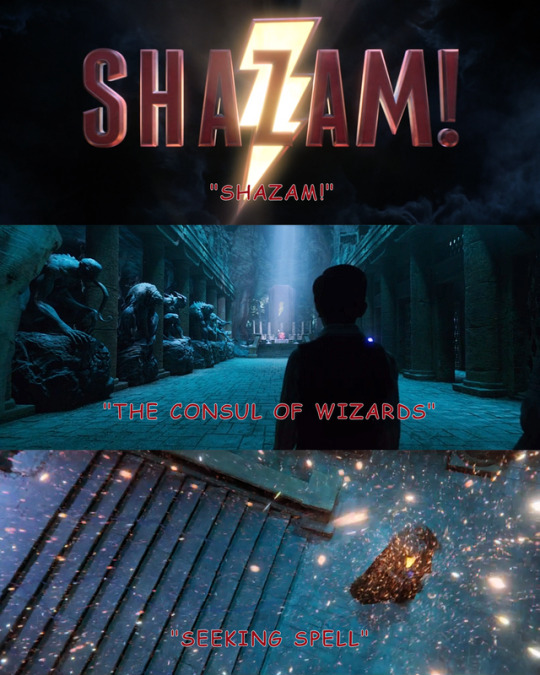
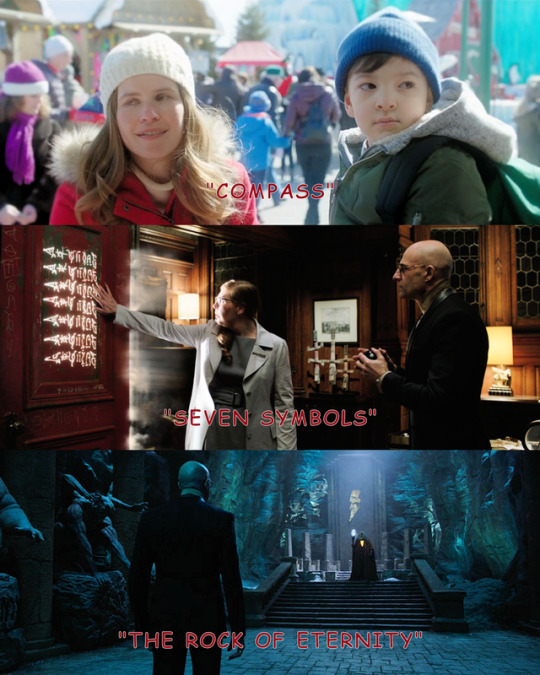
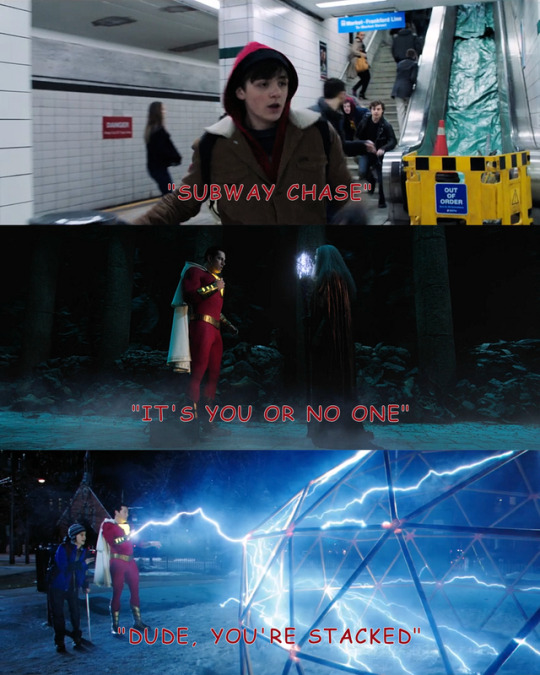
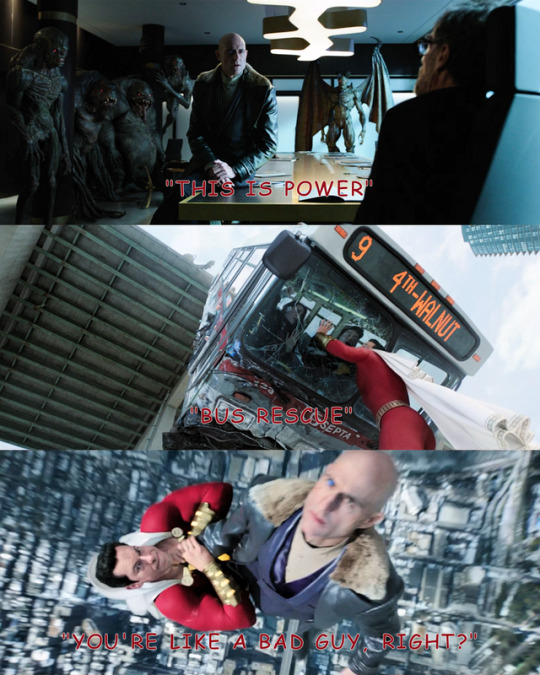
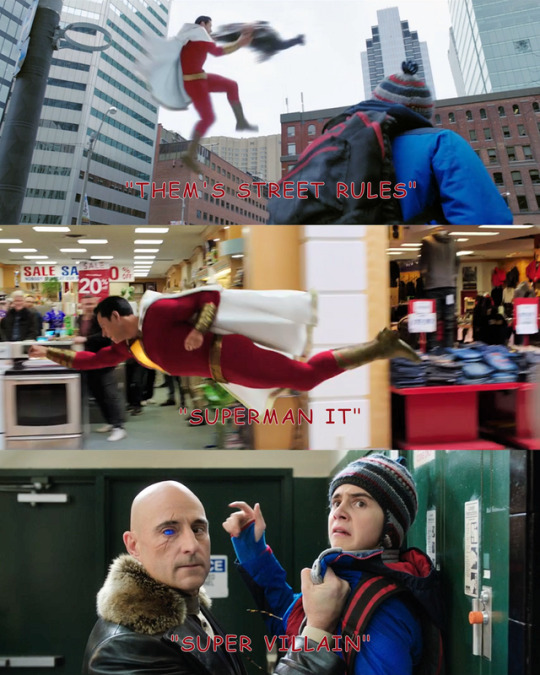
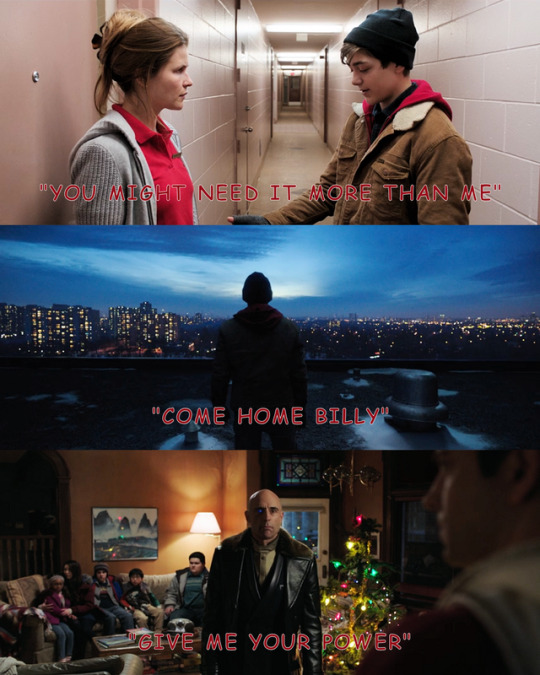
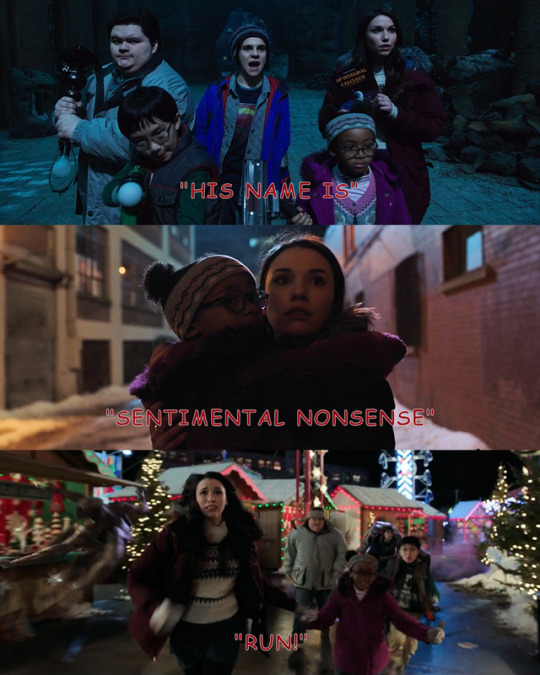

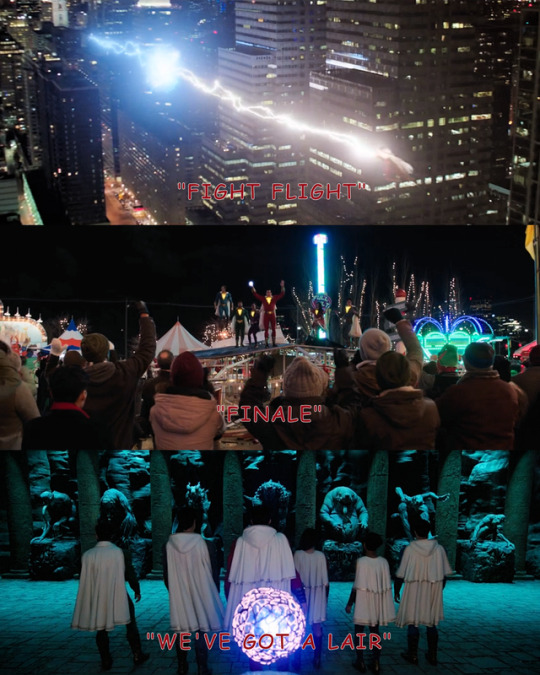
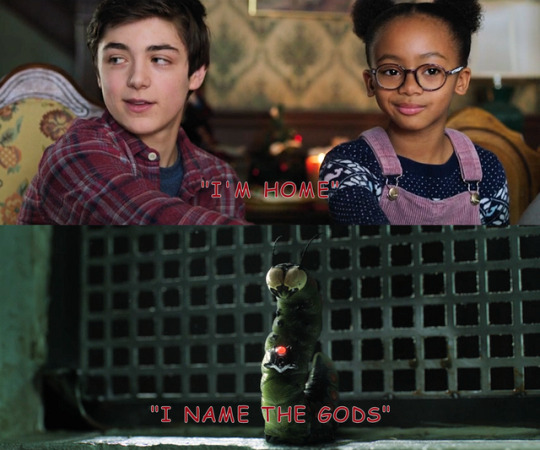
Music, Maestro!
You, Darla fans, remember that one publication I made about the non-orchestral songs for the film Shazam!, right? Well, here are now the full orchestral songs of that same film, conducted by Londoner Benjamin Wallfisch. But first, here is his bio:
Born August 7, 1979 as Benjamin Mark Lasker Wallfisch, the son of Elizabeth Wallfisch (née Hunt), an Australian Baroque violinist, and Raphael Wallfisch, a British cellist. He is the eldest of their three children. His paternal grandparents are pianist Peter Wallfisch and cellist Anita Lasker-Wallfisch, who was a member of the Women's Orchestra of Auschwitz. They were Jewish emigrants from Breslau, Poland.
He has composed and contributed to music for over 60 feature films since the mid-2000s. Asides Shazam!, his compositions include original scores for A Cure For Wellness, Hidden Figures, Lights Out, Desert Dancer, It (2017 version) and Blade Runner 2049. In 2017, he was jointly nominated with Pharrell Williams and Hans Zimmer for Best Original Score at the 74th Golden Globe Awards for his work on Hidden Figures, and a BAFTA Award and Grammy Award for Blade Runner 2049.
In 2014, Wallfisch was appointed an Associate of the Royal Academy of Music, London. He is also a member of Remote Control Productions, a company by Hans Zimmer.
Wallfisch resides in Los Angeles, California with his wife Missy and daughter Lola.
Here is the YouTube link to the soundtrack available to hear: https://www.youtube.com/playlist…
Music 1 - The Shazam! theme is played during the end credits, right after the mid-credits scene.
Music 2 - In a flashback scene from 1974, young Thaddeus Sivana (Ethan Pugiotto), while riding with his father and older brother in Upstate New York on Christmas Eve to his grand-parents' mansion, got suddenly transported, alone, to a place called the Rock of Eternity where he would meet this mysterious wizard as this latter was looking for a pure-hearted champion to replace him. However, after being tempted by the Seven Deadly Sins, trapped in statues, to take the Eye of Sin for power, the wizard reconsidered and sends him back to 1974. This piece was heard during that scene.
Music 3 - This score was played while the Shazam! Wizard, growing weaker, uses his seeking spell to continue looking for a champion, no matter how long it takes. It would finally pay-off in the year 2019 in Philadelphia - to a street boy named Billy Batson.
Music 4 - Billy Batson, age 14, kept on searching for his long lost mother since a decade ago from place to place, until he found one hoping this would be it, This piece was heard while he reminisced about how he lost his mother at a carnival. We see little Billy, age 4 (David Kohlsmith), with his mother (Caroline Palmer) as she was trying to pop the balloons with darts to win a prize for her son.
Music 5 - The once young Thaddeus Sivana has eventually grown up and becomes Dr. Sivana, who had never forgotten his encountering in 1974 and vowed to return to the Rock of Eternity and gain power from the Eye of Sin. While we hear this score, Sivana figured out, through interviewed witnesses from around the world, that there were seven symbols needed being written seven times. A skeptical Dr. Lynn Crosby (Lotta Losten) didn't believe it until the door in Sivana's office activated the passage to the cave - and in the process reducing Dr. Crosby to dust, but her glasses.
Music 6 - Returning at last to the Rock of Eternity after all these years, Dr. Sivana confronts the Shazam! Wizard (Djimon Hounsou) to take the Eye and gain power, which he finally did and got the best over the wizard while this score is playing along.
Music 7 - Billy Batson (Asher Angel) is being chased by the Breyer twins (Carson MacCormac & Evan Marsh), in the background, from Fawcett Central School to the nearest subway station after rescuing his foster brother Freddy from their bullying. This incident was perhaps fate as the following event will occur, changing his life forever. This music was played throughout.
Music 8 - While this music is played, Billy meets the wizard choosing him as the new champion. By saying the magic word and touching his staff, the wizard can at last transfer his powers to the new champion, Shazam!, giving him: - The Wisdom of Solomon - The Strength of Hercules - The Stamina of Atlas - The Power of Zeus - The Courage of Achilles - And the Speed of Mercury The wizard then vanishes into dust, leaving Billy with his new adult body and super-strength.
Music 9 - Knowing that his new brother, superhero fanboy Freddy (Jack Dylan Grazer), might help him with his new identity, Shazam! (Zachary Levi) lets him in on his secret. Together, they found that he was indeed "stacked" with super-powers.
Music 10 - Revenge can be sweet, whether for good or bad, as we see Dr. Sivana, after killing his brother Sid along with the other members of a board meeting at Sivana Industries, confronting his father (John Glover) to make him see that he gained power, with the help of his allies, the Seven Deadly Sins - and killing him as well afterwards.
Music 11 - While showing off his new lightning powers to the people outside the Philadelphia Museum of Art, Shazam! accidentally struck a bus's front tire, driving it to the edge. After his awkward attempt to use an old mattress in hoping it would soften the fall, our new hero had to catch the enormous vehicle - with a satisfying result, saving everyone inside it.
Music 12 - Dr. Sivana finally meets this new champion and demands him to hand his powers over to him immediately. This battle with a super-villain was Billy's ultimate test. Sivana however got the best of him, as our new hero couldn't fly yet, by grabbing him and bringing him up high in the atmosphere and lets him go to a dooming fall.
Music 13 - After his dooming fall, Billy halted to a close shave as he could finally fly and had to deal with this new foe in black in a new definition of street-brawling, all under the watchful eye of Freddy.
Music 14 - The brawl between Shazam! and Dr. Sivana went on as they ended up in the mall and in a toy store. After being slammed by Sivana through the store window, Shazam! had to get away from him by flying inside the mall before being struck by Sivana. Having no choice, Shazam! transformed back to Billy in order to blend in with the panicking crowd.
Music 15 - Seeing that Freddy was looking for Billy, and realizing the latter would supposedly be the new hero according to the bus rescue news report on the TVs at the mall, Sivana forced the crippled fanboy to tell him where he lives, which would put the other kids in danger as well.
Music 16 - At long last! Billy, thanks to Eugene's search online, has finally found his long-lost mother, Marilyn, who has moved on and remarried while his real father, C.C., was in prison in Florida for ten years. Billy found out that she has abandoned him on purpose because she couldn't afford to keep him since she was too young. Billy then tells her that he too had to move on to his new family.
Music 17 - After his reunion with his real mother, Billy received a call from Freddy's phone by Dr. Sivana, letting him know that he holds his foster siblings hostage and demands that he comes home immediately.
Music 18 - Forcing to return home to save the others, Billy was ordered by Dr. Sivana to relinquish his powers to him after their arrival to the Rock of Eternity and will let them go, or else they will die. In tears, Darla (Faithe Herman) pleaded Billy not to go and stay with them, but Billy tells our bespectacled beauty that that's what good big brothers would do.
Music 19 - Following Billy and Dr. Sivana to the Rock of Eternity, Darla, Eugene (Ian Chen), Freddy, Pedro (Jovan Armand) and Mary (Grace Fulton) found whatever they salvaged from home and decided to take head on against Sivana and his "big fat ugly-eyed head, " as Darla would put it bravely, until he lets Billy go.
Music 20 - Here, we see Mary being such a great big sister watching over Darla as they watched Dr. Sivana blasting out through the roof of The Booty Trap strip club. The kids have no time to waste and ran to the nearby carnival in hoping to lose themselves inside the crowd. Protect our little Darla, Mary. We love her so much.
Music 21 - In a divide and conquer method, Mary would hope that Sivana would not be able to follow all of them. However, the dangerous doctor sends his Seven Deadly Sins after them, and succeeded.
Music 22 - Billy managed to escape from the clutches of Dr. Sivana, but the latter has the others hostage, yet again, inside the big tent. When he threatened of having Darla killed by Greed (YOU MONSTER!!!), Billy had no choice but to give in.
Music 23 - While Billy had to relinquish his super-powers to Dr. Sivana, he remembered what the wizard told him about sharing his power with the others by simply touching the staff. Not giving up yet, he managed to defeat Sivana and taking the staff away from him, with enough time to share his powers with his new family, becoming superheroes themselves.
Music 24 - It is done - the kids, thanks to Billy, have now become superheroes with their own unique abilities, including Freddy who can now fly as Super Hero Freddy (Adam Brody, in blue) with full joy.
Music 25 - While our new family of superheroes fight against the Seven Deadly Sins, Shazam! and Dr. Sivana face-off for what may be a final showdown in the Philadelphia skyline.
Music 26 - Shazam and the rest of the Shazamily finally won against Sivana and saved the city from destruction. And at the same time, they gained fandom from the cheers and applause of Philadelphians, resembling very much of a big stage play.
Music 27 - Returning back to the Rock of Eternity and placing the Eye of Sin back to its rightful place, thus imprisoning the Seven Deadly Sins back in statues, they realize along the way that they have something else - a lair. They have their own lair - something Billy and Freddy were looking for during the film, even by asking a real estate agent about one.
Music 28 - The following Christmas morning, the whole family gathered for breakfast and Billy told them that he finally found a new family - them - and how much he is very grateful for that.
Music 29 - In a mid-credits scene, when we hear this musical score, an imprisoned Thaddeus Sivana, still looking for a magic formula by writing on the walls, is approached by this talking caterpillar, going by the name Mr. Mind, who proposes an alliance between the two and there are alternate ways in discovering magic.
#shazam#shazam movie#shazam film#shazam ost#music in film#music in movies#darla dudley#faithe herman#eugene choi#ian chen#freddy freemen#jack dylan grazer#pedro pena#pedro peña#jovan armand#mary bromfield#grace fulton#billy batson#asher angel#zachary levi#thaddeus sivana#mark strong#shazam wizard#djimon hounsou#mister mind
22 notes
·
View notes
Quote
On Zimmer Gespräche, 2006: The work Zimmer, Gespräche is the result of a grant I received in the form of a residency at GfZK, Leipzig. It was the year 2005. I scanned the internet to find out what there was in Leipzig that I could use as a starting point for this residency. I read about the Museum in der Runde Ecke – the former Stasi headquarters in Leipzig – which had been occupied by the people in revolt in 1989. Leipzig was the birthplace of the peaceful revolution, "Die Wende", which ended the communist government and brought about the fall of the Berlin Wall. In the course of events leading up to this, Leipzig citizens observed that thousands of documents were being destroyed every night at the Stasi headquarters – a sinister building and an organisation that had embittered their lives for decades. So, overnight, the population occupied the headquarters and stopped the destruction of documents. They then began the painstaking work of recovering the archives. The documents were there, but they were coded; they had to be deciphered, and they could not expect any help from former Stasi employees. So very slowly the stories of surveillance, repression and suffering started to emerge, and they were there, in the museum to see and to read. They revealed how the dark shadow of suspicion and fear was present even in the most banal everyday things, how everyone was aware that they were being listened to, watched, by their closest friends, sometimes by their lovers. The psychology of the informer was something fascinating for me. There was the case of a woman, the leader of a feminist group, who discovered, once the Stasi archives opened, that her husband – father of her three children – had been informing on her since the very first day they met. They divorced immediately, and the husband was left more perplexed than repentant: for him it was perfectly possible to love his wife and to spy on her at the same time. "I was trying to protect her" he said. How could you be both intimate with and a traitor to the person you loved? How could control and repression be disguised as care and attention? Then I encountered the stories of what were called "inoffizielle Mitarbeiter" - people, your friends and neighbours, who were secretly and unofficially working for the Stasi. No one knew they were Stasi collaborators because they were often members of the most politically critical groups, the resistance to the totalitarian communist government. On the surface, they were fighters against the establishment, and at the same time, under the surface, agents of this establishment. Curiously, I found that their meetings with their connecting Stasi officers were arranged very much as a clandestine love meeting might be. These meetings took place in private apartments normally belonging to single young males who accepted the deal of lending their apartment for these meetings in exchange for party favours: a lower rent, a job. They were instructed that when a signal was given – a phone call, a knock, a plant that changed place – they should leave the apartment. Then the Stasi officer arrived, who was told to arrange the apartment to make it "pleasant": warm, clean, with coffee and sweets, light, plants if possible. Once the apartment was in the desired condition, the informer would arrive, and informer and officer would drink coffee amiably together, exchange information, and then they would leave, always separately, so that people could not make any connection. Then there would be another signal, and the owner of the flat would come back. Doesn't it sound like a secret love rendezvous? I could imagine the complexity of such a relationship, informer and Stasi officer, no one knowing they were meeting, even more complex if the informer was a woman – the Stasi officer was always a man, since women were considered "inadequate" for such a delicate job. Of course, there was no documentation of such meetings, nothing had been filmed or recorded. I wanted to make a film about such an encounter, to imagine how it was, to imagine what was said. So, I made the film Zimmer, Gespräche (Rooms, Conversations). I wanted to present the power game between informer and officer, imagining that we could easily assign the role of master to the officer, and slave to the informer. But the meeting in the film takes place when everyone senses that the Communist Bloc is crumbling, and therefore, somehow, the power is changing sides. Who depends on who? What kind of society do they constitute, and what are their possibilities of survival in the new world that is approaching?
1 note
·
View note
Photo

Friday Black by Nana Kwame Adjei-Brenyah || Book Review
ATY in 52 Books | A book that was nominated for or won an award in a genre you enjoy (National Book Foundation Honoree, 5 Under 35)
Synopsis | In the stories of Adjei-Brenyah's debut, an amusement park lets players enter augmented reality to hunt terrorists or shoot intruders played by minority actors, a school shooting results in both the victim and gunman stuck in a shared purgatory, and an author sells his soul to a many-tongued god.
By placing ordinary characters in extraordinary situations, Adjei-Brenyah reveals the violence, injustice, and painful absurdities that black men and women contend with every day. These stories tackle urgent instances of racism and cultural unrest and explore the many ways we fight for humanity in an unforgiving world.
REVIEW
I’d never really been one to go for short stories in the past. Preferences aside, this collection seemed to be more my speed, so I gave it a shot. Just the titles alone had me intrigued to want to find out what could be behind them, and I was never disappointed in what I found. Reading through this felt like watching mini episodes of Black Mirror, and I wouldn't mind seeing some of them expand into full novels.
Highlights
The Finkelstein 5
Emmanuel started learning the basics of his Blackness before he knew how to do long division: smiling when angry, whispering when he wanted to yell.
An extremely surreal tale about seeking justice for those who lost their lives at the hands of those “protecting” themselves. I knew from the first sentence that I was in for a wild ride and this did not disappoint. The switching between the court room proceedings and Emmanuel’s day and thought process was really strong, especially when the events and outcome seemed to fuel his motivation. It did make me angry in parts just because it felt so close to home in relation to all the shootings and killings over the last few years, but the ending, while dark, still made me feel like an anger was released.
The Era
Everybody gets their mandatory Good in the mornings with breakfast at school, but they have extra at the nurse’s. I go to the nurse because Good makes me feel good. When I have Good, it’s easy to be proud and truthful, and ignore the things that cloud my truth, like Marlene, or being made into an example, or knowing I’ll never be perfect.
This was an interesting take on the quest for perfection and what we as a society will put ourselves through to achieve it. It also said a lot about how we often look down on expressed emotion, like when people speak their mind on current issues going on in society and are then told to calm down and stop being “sensitive.” There were many instances here that I could see happening in an episode of Black Mirror, which is a little terrifying because so many things depicted don’t seem that far away from reality.
Lark Street
An impossible hand punched my earlobe. An unborn fetus, aborted the day before, was standing at my bedside. His name was Jackie Gunner.
A dark, but really interesting tale about a man being confronted face to face with his aborted twins. Parts of this were really sad, especially in terms of the conversations the father had with his would-be children. It ultimately came down to a matter of preparedness and abandonment, which gave this a lot of meaning for me.
Zimmer Land
Zimmer Land Mission: 1) To create a safe place for adults to explore problem-solving, justice, and judgement. 2) To provide the tools for patrons to learn about themselves in curated heightened situations. 3) To entertain.
Of the 12, this one reminded me of Black Mirror the most, specifically the White Bear and Black Museum episodes. The title alone gave me an inkling to what the overall story might be about, but much like Finkelstein 5, I wasn’t entirely prepared for what I would find. The read was really disturbing at times, especially factoring in the idea that people might actually participate in something like this and get any amusement out of it.
Friday Black
Ever since that first time, since the bite, I can speak Black Friday. Or I can understand it, at least. Not fluently, but well enough. I have some of them in me. I hear the people, the sizes, the model, the make, and the reason. Even if all they’re doing is foaming at the mouth.
This one hit close to home for me working in retail, especially during the craziness of the holidays. I really liked the take on this with someone who’s been doing this for so long that they speak another language, in this case being zombie-like customers who will do anything for the latest winter coat. It made Black Friday seem more like a viral outbreak that consumes every ounce of an individual’s humanity and turns them into a mindless creature (which it seems to be doing more and more each year, to be quite honest).
Light Spitter
The ghost of Fuckton walks from the bathroom, drawn to the angel floating over her former body, which is limp and bent over the back of a cushy chair. Deirdra and Fuckton see each other.
“What happened?” Fuckton asks.
Deirdra turns her head and tries to spit on Fuckton, but all that comes from her mouth are slim rays of light. After trying and failing to do anything but shine, she says, “You killed her - me. You killed me.” Fuckton stares at the angel. She looks just like the dead girl on the chair used to. Then he looks at the body.
“Oh, yeah. That feels like it was ages ago. My bad,” Fuckton says.
Much like the confrontation in Lark Street, this was another interesting take on a conversation between two parties that I’d never considered. It brought to mind something I’ve always wondered whenever these mass shootings occur - What exactly goes through the mind of a killer? And if they survive, do they ever have any remorse for the lives they took and the aftermath they’ve caused? I really appreciated the path this took with the two spirits navigating their way through their new existences, trying to help prevent similar catastrophes and opening themselves up to communication, possibly even forgiveness down the line. This could absolutely be a good conversation starter for a much needed and overdue discussion on what went wrong with those that have already happened and how to prevent more from happening in the future.
Overall, this was such a wild ride of beautifully interesting and creepy imagery with a wide range of genres and topics, and I can’t wait to read even more in the future!
Rating | 🌟🌟🌟🌟🌟 Goodreads
#friday black#nana kwame adjei-brenyah#short stories#the finkelstein 5#things my mother said#the era#lark street#the hospital where#zimmer land#the lion & the spider#light spitter#how to sell a jacket as told by iceking#in retail#through the flash#around the year in 52 books#aty 2019#reading challenge#booklr#bookblr#book review#black authors
2 notes
·
View notes
Photo

Jimi’s Nightmare
by Bruce Gray
Dimensions: 31 x 13 x 2
Located: The Zimmer Children’s Museum in Los Angeles.
1 note
·
View note
Photo


Leighton Meester attends Zimmer Children's Museum's 3rd Annual We All Play Fundraiser in Santa Monica, California on April 28, 2018
#lmeesteredit#ggcastedit#flawlessbeautyqueens#breathtakingqueens#dailywomenedit#event#**#by becca#2018
133 notes
·
View notes
Text
All Things Linguistic - 2017 Highlights
In 2017, podcasting turned from a fun new experiment into a real, self-sustaining project, I checked off half of the American states on my have-visited list thanks to conference rotation (lifetime, not just in this year), and I got my book way closer to being a real thing you’ll get to see soon.
Lingthusiasm podcast
My podcast with Lauren Gawne, which launched towards the end of 2016, had a full year of episodes, a sold-out liveshow at Argo Bookshop in Montreal and reached over 100k listens!
4. Inside the Word of the Year vote 5. Colour words around the world and inside your brain 6. All the sounds in all the languages – the International Phonetic Alphabet 7. Kids these days aren’t ruining language 8. People who make dictionaries: Review of Kory Stamper’s book Word by Word 9. The bridge between words and sentences — Constituency 10. Learning languages linguistically 11. Layers of meaning — Cooperation, humour, and Gricean Maxims 12. Sounds you can’t hear - Babies, accents, and phonemes 13. What Does it Mean to Sound Black? Intonation and Identity Interview with Nicole Holliday 14. Getting into, up for, and down with prepositions 15. Talking and thinking about time
We also launched a Patreon for the podcast, and released 10 bonus episodes there:
Swearing and pseudo-swears
How to teach yourself linguistics
How to explain linguistics to employers (text chat)
Doggo linguistics behind the scenes
Hypercorrection
Language play
DIY linguistic research
Hark, a liveshow! So, like, what’s up with discourse markers?
Is X a sandwich? Solving the word-meaning argument
Liveshow Q and eh
In addition, we launched some lingthusiastic merch: scarves with a subtly nerdy IPA print on them, stickers with our logo, and various items that say NOT JUDGING YOUR GRAMMAR, JUST ANALYSING IT.
Book
I did a lot of behind the scenes writing on my book about internet language, which will be published by Riverhead at Penguin. All you got to see about it for 2017 was this update about line edits and a few cryptic tweets, but stay very much tuned for more updates about it in 2018!
You can sign up for very occasional email updates about the book here, if you want to make sure you don’t miss it on social media.
Talks, workshops, and teaching
A linguistics museum called Planet Word was announced for Washington DC. I’m on the Advisory Board, and I went to New York City in October for a planning meeting
Internet linguistics at SpaceWitchCon, in the woods of North Carolina
How I Became An Internet Linguist: Princeton linguistics colloquium talk
At the Linguistic Society of America annual meeting in Austin, Texas:
Stumbling into linguistics via blogs and Wikipedia at a panel on Getting High School Students into Linguistics which I co-organized with Moti Lieberman. Panel slides and abstracts.
How people lengthen words on Twitter, co-authored with Jeffrey Lamontagne – slides at bit.ly/longggg.
Judge for the Five Minute Linguist talks
At South by Southwest in March:
Moderated a panel called Word Curation: Dictionaries, Tech and the Future with Erin McKean (Wordnik), Jane Solomon (Dictionary.com), and Ben Zimmer (Wall Street Journal).
Erin, Jane, and I judged an emoji spelling bee organized by Jenny 8 Lee and other people from EmojiCon.
At the LSA institute in Lexington, Kentucky in July, I taught a four-week class on communicating linguistics or LingComm Here’s the class notes as blog posts:
Day 1: Goals
Day 2: Terminology and the explainer structure
Day 3: The Curse of Knowledge and short talks
Day 4: Myth debunking and in-person events
Day 5 & 6: Events, self-promotion, and charades
Day 7 & 8: Pitching and final projects
I also livetweeted the Lingstitute plenary talks:
Using games to measure how people match the conversational styles of their interlocutor
Children should be educated in a language they actually speak: Haitian Creole and linguistic colonialism
Come for the sociolinguistics; stay for the lumbersexuals
Combatting stereotypes about Appalachian English
Expanding historical linguistics beyond standardized print texts and into non-standard varieties
The linguistics of talking to sheepdogs
“Verbal Gestures” often include sounds that aren’t in a language’s words but which are very important for communication
I did lingwiki Wikipedia editathons at the LSA annual meeting, Lingstitute, and the International Conference on Language Documentation and Conservation (ICLDC) in Honolulu, Hawaii in March.
Media
I wrote an op-ed for the Washington Post: Herefefe is why it’s toughfefe to say “covfefe”, which was picked up by the Guardian, Longreads, and El Pais (Spanish).
The first episode of Lingthusiasm was also featured in NY Mag’s Science of Us and on #SciFriLive (Science Friday on NPR).
A few articles I was quoted in:
New York Times: on Snapchat and phatic communication, on the communicative function of emoji (Gaymoji) in Grindr, on how we type laughter online.
NPR All Tech Considered: on the linguistic style of doggo, pupper, and the rest of the dog rates/dogspotting meme, on twitter threads (tweetstorms).
NY Magazine: The Internet Tilde Perfectly Conveys Something We Don’t Have the Words to Explain.
CBC Spark: on digital tools revitalizing minority languages
Al Jazeera The Stream: on emoji (watch here)
The World in Words: on “aliebn-speak” or the linguistic style of jomny sun.
Linguistics jobs
I moderated a panel about careers in linguistics at the annual meeting of the Canadian Linguistics Association in Toronto. Linguistics jobs interviews that aired on the blog:
Jane Solomon, lexicographer at Dictionary.com
Project manager at a language learning software company
Project manager a language tech company.
Librarian
Digital humanities librarian
Speech pathology
User experience research
Text analyst
Communications consultant
Quote from Bringing Linguistics to Work
Selected blog posts
I hit my 5-year blogiversary! Here are a few of my favourite posts from 2017:
Roundup posts:
A list of linguistics and language podcasts
A very long list of linguistics movies, documentaries, and TV show episodes
Linguistics Halloween costume roundup
Linguistics merch gift guide
How to teach yourself linguistics online for free
Linguistics handmade things
Schwa cookies!
Gingerbread wugs and IPA
Knitted IPA door handles and a stuffed wug
A wug-tastic addition to the linguistics baked goods files
An embroidered IPA vowel trapezoid with animals
Example sentences:
Two lobsters, a baby octopus, and 21 vodka oyster shots…before running into the sea
The new Buffalo buffalo… sentence is about a fish called Boops boops
Yahoo Answers takes on the type-token distinction
“Amelia Earhart flies, like, a plane.”
Local man fond of linguistic garden path sentences friends to hearing his boring puns Structural ambiguity: Lindsay Lohan and the snake, who calls their cat toxoplasma gondii?, true self control is waiting until the movie starts to eat your popcorn, ultraviolet wine, “You can’t eat a dumpling wearing a tuxedo!”, the sad and lonely man science has left you
Things about languages:
A longread on whistled languages around the world
RIP the inventor of pinyin
A schematic of why the Korean alphabet is so cool
Irish spelling has its own historical logic
The different versions of “I” in Japanese
The middle finger in American Sign Language
Egyptian hieroglyphs in Unicode
How to revive Massachusetts’s first language
The Universal Declaration of Linguistic Rights
Deciphering ancient Incan khipu string code
New paint colours invented by neural network
A great visualization of Canadian Aboriginal Syllabics
Clip of someone whistling a sentence in Spanish
The most common speech sounds in languages around the world
The problems with talking about “oldest languages”
Latin, Ancient Greek, and Sanskrit triplets
Playing wax cylinder recordings of Indigenous languages with lasers
The Vocal Fries does an interview about Rez English(es) and indigenous language revitalization
Native American Hand Talkers fight to keep sign language alive
An exercise for teaching about iconicity in ASL for intro linguistics classes
Google Translate adds gender stereotypes when translating from Turkish
Other linguistics:
Gifs and videos about aphasia
Hidden sounds in English that you don’t realize you’re saying
An interview with Alexandra D’Arcy about why “like” is so interesting
Pink Trombone, an interactive simulation of the vocal tract
“Becoming conscious of previously unconscious phenomena is one of the principle joys of linguistic work”
A sentence containing all the vowels in (some dialects of) English
The linguistics of talking backwards
Three interesting articles by Julie Sedivy in Nautilus Magazine, about the role of linguistics in literature and more
“Lexicography moves so slowly that scientists classify it as a solid”
The relationship between gesture and thinking/speaking
A graph of a kid’s first words
Conlang summer camp for high school students
An intro to the field of computational sociolinguistics
Spenser vs Shakespeare: a response to grammar policing
How to tell apart the two “th” sounds in English
Inclusive and exclusive “we”
Phonemes as Pokémon cards and the first conference on Pokémonastics
Deaf babies, when exposed to ASL, start to babble with their hands
“Linguists are interested in your intuitive sense of grammaticality”
How to type IPA on your computer or phone
When does maluma/takete fail? The language’s sound system matters
Sign languages have accents
Why sign language gloves don't help Deaf people
The strange reason deaf children aren’t taught sign language
Internet linguistics:
“lol” as “this is to indicate that this brief text isn’t hostile”
when you accidentally type a capital letter at the beginning of a sentence
Phoenician letters as emoji
How many times people repeat the “u” when saying “fuck” on twitter
Question mark in parentheses (?)
Winnie-the-Pooh used Ironic Capitals
Memes:
“i lik the bred”, a meme of rhyme and Middle English
you: *cough* me, a linguist: aspirated glottal stop
Is your child texting about phonetics?? meme
OK is a fossilized meme
You’ve heard of Elf on the Shelf, now get ready for…phonemes on the memes
Missed out on previous years? Here are the summary posts from 2013, 2014, 2015, and 2016. If you’d like to get a much shorter monthly highlights newsletter via email, you can sign up for that on my website.
263 notes
·
View notes
Link
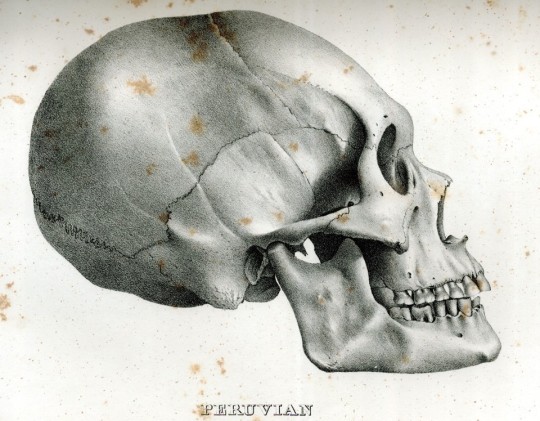
A diagram of an "ancient Peruvian skull" from Samuel George Morton's Crania Americana
Peruvian archaeologists are tired of debunking claims of extraterrestrial influence on human history. In 1968, Swiss author Erich von Däniken’s Chariots of the Gods? introduced the mainstream to the theory that the Nazca Lines, the massive geoglyphs in Southern Peru whose shapes are fully visible only from the air, were landing strips for “ancient astronauts.” Archaeologists calmly disagree, positing that they were astronomical designs that turned the desert itself into an observatory, or counter constellations matching the dark spaces in the Milky Way, or, more abstractly, cosmological figures meant to be seen by skyward deities, of which ancient Peru had many. 2008’s Indiana Jones and the Kingdom of the Crystal Skull put a new spin on this old tale, including, for good measure, the large-skulled aliens that pepper North American abduction stories.
Now, Peruvian scientists are furious at a new and possibly pernicious permutation of the “ancient astronaut” theory. A web series named Unearthing Nazca purports to depict the investigation of a pre-Columbian and “humanoid” mummy. Archaeologists, who have been denied access to the mummy, worry that it is as old as the series’ creators claim, but that it is actually indigenous and Andean—a real human individual that has been mutilated to look like an alien. They worry that Unearthing Nazca is an archaeological snuff film in disguise.
The series’ success is also of concern. Since the series’ launch in June by Gaia.com—a website specializing in “conscious media, yoga, and more”—the teaser episode of Unearthing Nazca has been viewed 2.35 million times on YouTube alone. It starts with what at first seems to be a typical seated Peruvian mummy, arms wrapped around its knees, like a child waiting for its parent. Its head is elongated like those of other pre-Columbian mummies, whose societies artificially shaped their children’s crania to achieve ideals of beauty or represent group belonging.
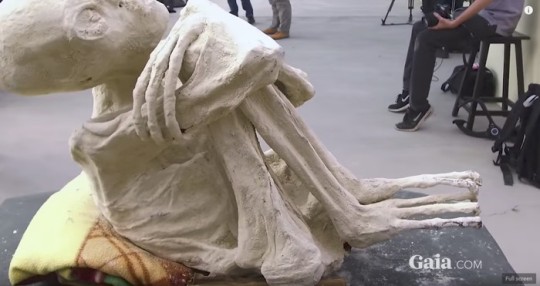
“Maria,” the “humanoid” mummy from the Gaia.com web series Unearthing Nazca (Screenshot from Gaia.com)
The resemblance ends there. A Hans Zimmer-esque score throbs, and a Russian-accented expert in “bioelectrography”—who elsewhere claims to have photographed the human soul escaping the body after death—declares the mummy “one of the most important discoveries of the 21st century.” The camera orbits the mummy, revealing that it has only three long fingers on each hand and three long toes on each foot. Its elongated head has no nose, no ears, and large, heavy-lidded eyes. And its skin is an eerie, powdery white.
The video’s experts stop short of the A-word, letting a series of vest-wearing and white coat-clad “experts” claim that x-rays, CT scans, and DNA and carbon-14 tests of the mummy’s flesh reveal that this new “humanoid” or “organic creature,” whom they have dubbed “Maria,” is no fraud. To learn more, viewers were initially encouraged to watch the rest of the investigation behind Gaia’s paywall.
The English- and Spanish-language tabloids and YouTube channels that cover the “discovery” reliably fill in the blanks, guarding journalistic integrity with scare quotes: “The ‘Alien’ Mummies of Nazca,” trumpeted The Sun in mid-July, when the mummy’s most prominent promoter, a Mexican “ufologist” and TV personality named Jaime Maussan, produced photographic and x-ray “proof” of at least four additional more “reptilian” “humanoid” bodies.
Because of course: What else could they be?
* * *
Human beings, and indigenous ones to boot.
In 2015, Maussan tried to promote a photographic slide from the late 1940s that, he hinted, depicted the corpse of an alien child found in the American Southwest. More skeptical ufologists applied de-blurring technology to the “Roswell Slide” when it was released, and found that a previously undecipherable placard next to the body revealed that it was actually the mummy of a two-year-old Puebloan boy removed from the cliff dwellings of Mesa Verde in 1894. Returned to a National Park museum in 1938, the boy was repatriated to a local tribe in 2015. Incredibly, Maussan then offered $10,000 for information that might permit the Puebloan boy’s “location and recuperation.”
This inclusion of pre-Columbian Peruvians in science’s supposed cover-up of extraterrestrials echoes the previous collection and study of the indigenous dead. In the 19th century, Anglo-American and European craniologists and scholars who came upon artificially molded skulls in Peruvian tombs hypothesized that they were either the undeformed remnants of a lost and civilized people they named the “Ancient Peruvians,” or artificial deformations of later peoples inspired by those Ancient Peruvians’ natural forms. Archaeologists came to realize that “deformed” Peruvian skulls were bound and shaped from infancy, when cranial bones weren’t yet fused—with no change to cranial capacity and, judging from the monumental societies their elites achieved, without handicap to cognitive ability. But ufology’s rise after the “Roswell incident” of 1947 has resurrected the search for secret ancestors—and its less responsible practitioners have re-enlisted ancient Peruvian skulls as evidence of the presence of large-skulled “Gray Aliens.” They speculate that Peru’s greatest pre-Columbian achievements—including Machu Picchu, according to a theory aired on the History channel program Ancient Aliens—are literally out of this world, the product of a superior, extraterrestrial “race” or their borrowed technology.
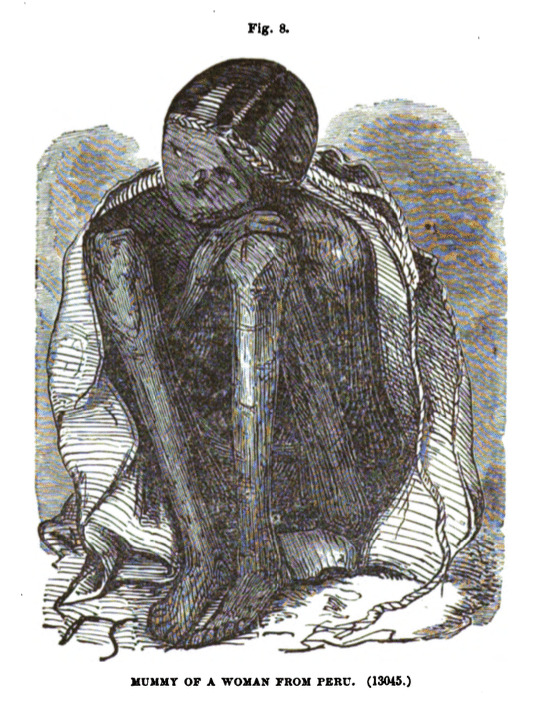
Illustration of a mummy collected and unwrapped in 1836 by John Harrison Blake (Peabody Museum of Archaeology and Ethnology)
The use of the word “race” is telling, as it suggests how the repurposing of older, European collections of non-European bodies and research upon them can reproduce old and debunked theories of racial deficiency: that indigenous Peruvians, in particular, could not have built such advanced, monumental societies on their own. (“Ancient astronaut” theorists claim evidence of extraterrestrial inspiration worldwide, but only indigenous Americans see their bodies and achievements remade as only explicable by alien presence.) From the 18th century on, Northern Europeans have accused the Spanish of exaggerating or misidentifying the origins of the Incas’ achievements. Alexander von Humboldt asserted that the first Incas were actually Chinese. Inca embalming of their dead was attributed instead to natural mummification by the elements or to the diffusion of Egyptian knowledge.
With the rise of specifically racialized science in the 19th and 20th centuries, evidence for Native American otherness was sought in the ancient Peruvians’ very bones. In the 1920s, one German scholar and future SS officer would seek confirmation that the Andes’ most megalithic cultures were actually Aryan or Atlantean, and that their elongated skulls were of a higher, Northern European race. More dismissively, earlier scholars took ancient Peruvian skulls’ distinctive size, shape, and possession of unique interparietal bones as evidence of a similarity to rodents and marsupials, a contradiction that undercut their attributed civilization. In his great assault on racial bias in the scientific estimation of intelligence, The Mismeasure of Man (1981), Stephen Jay Gould famously claimed that the Philadelphia craniologist Samuel George Morton had “plummeted” the average size of Indian skulls in his collection by including a “major overrepresentation of an extreme group—the small-brained Inca Peruvians.”
* * *
Archaeology and museums have come a long way in their study and portrayal of an indigenous past in which Peruvians are proud, and conversations about the repatriation or more ethical study of the indigenous American dead are ongoing. (Simultaneous to Unearthing Nazca’s release, there was massive attendance at a new and decidedly non-extraterrestrial show on the Nazca culture at the Lima Museum of Art.) Gould’s use of Morton as an illustration of racial bias in science has also been debated—Morton actually used a grouped mean of the groups included among his “Americans,” controlling for the Peruvians’ greater presence so that their inclusion would not plummet the average.
Nevertheless, Unearthing Nazca is support for Gould’s larger warning against describing non-European bodies as deficient, abnormal, or non-human. The Internet in particular has provided a platform for claims of Peruvian skulls’ alien or alt-hominid abnormality that rely on the repetition of old scholarship without grappling with the racist presumptions behind the very metrics they used. Proponents of the idea that elongated Peruvian skulls were naturally occurring, for example, have embraced the work of Morton and his cohort, such as the Swiss author who compared the ancient Peruvians to marsupials. It also shows how zombified racial science—even when it claims not to be about race—might abuse actual human bodies.
It was for this reason that Unearthing Nazca broke Peruvian archaeologists’ studious reserve. The trouble began late last year, when the Peruvian YouTuber Paul Ronceros got local media to cover an earlier “alien” or “reptilian” mummy and separated three-fingered hand from Nazca, which he claimed were discovered by interested parties other than himself. At some point Ronceros brought that hand and the first “mummy” to a series of museums, including the natural history museum at Lima’s University of San Marcos, the oldest university in the hemisphere. According to that museum’s head of vertebrate paleontology, Rodolfo Salas-Gismondi—who is also an investigator affiliated with the American Museum of Natural History in New York—Ronceros changed his story when challenged on the obvious fabrication, claiming that it instead was a pre-Columbian “representation” of alien life, made of a mixture of animal and human bones. Around this time, Maussan and fellow international UFO “experts” got involved, declaring that the mummies in question—they kept multiplying—were fabrications, possibly ancient, but that others were “genuine, non-human biological remains.”
That archaeological human bones may have been used to mount Ronceros’s “reptile” mini-mummy and its accompanying hand was bad enough. But Peruvian scientists held their fire in public until June, when Unearthing Nazcarevealed the previously un-photographed “Maria,” whose dramatic resemblance to actual Peruvian mummies—down to an almost anatomically correct CT scan—suggested that she wasn’t a pastiche of animal and human bones, but an actual pre-Columbian Andean, looted and remade for the sake of a hoax.
From the x-rays of the mummified hands featured on Unearthing Nazca, Salas-Gismondi has proposed that they were part of a pre-Columbian mummy that was subsequently mutilated—two fingers or toes cut from each extremity and redeployed to augment the number of falanges in the remaining three digits to conform to our alien pop culture stereotypes. Its skeletal extremities, Salas-Gismondi observes, are otherwise identical to that of a human being with five fingers, which “makes no evolutionary sense.” To complete the package of “Maria,” her nose and ears may have been sliced away from what was either an unsurprisingly elongated head, or were left off of a recently fabricated one. Evidence of all alterations could easily be covered up with the white, plastery powder that the talking heads on Unearthing Nazca claim is a desiccant. The benefit of using an actual mummy is that the body may be probed for samples of actual pre-Columbian flesh, as some face-masked participants in Unearthing Nazca are seen to be doing in the name of “carbon-14 and DNA testing.” The “experts” later declare that those tests reveals that the mummy was a 1,600–1,800 year-old female “humanoid”—results that have not been verified by outside parties.
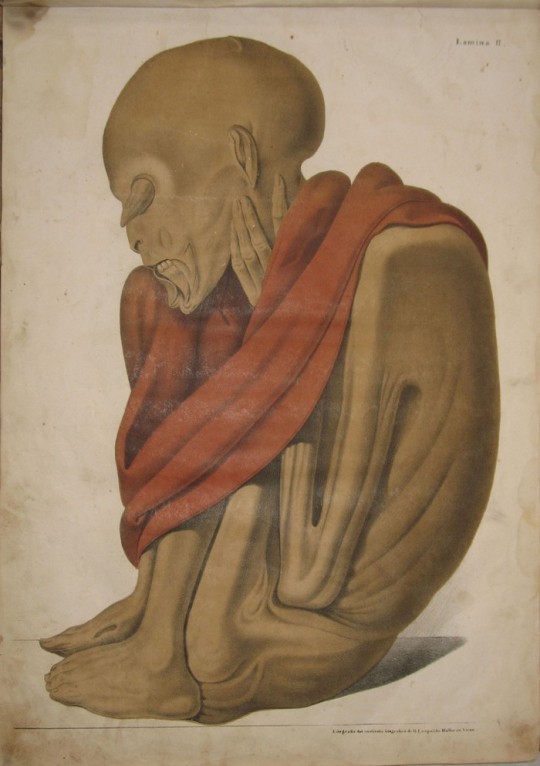
Pre-Columbian Peruvian mummy as depicted for the 1851 work Antigüedades Peruanas. (Mariano Eduardo de Rivero / Johann Jakob von Tschudi)
Maria’s guardians have not let her be examined by established mummy experts. In late June, Peru’s Ministry of Culture announced that it was investigating the possibility that the composition of the mummies were the product of looting. And in July, the organizers of last year’s World Congress on Mummy Studies in Lima—Peru’s actual experts on pre-Columbian remains—denounced Unearthing Nazca, calling upon Peruvian authorities to investigate, find, and prosecute the mummies’ apparent makers for violating Peru’s laws against trafficking in pre-Columbian human remains, which are considered Peruvian cultural patrimony. The Congress’s organizers were particularly galled by the possibility that this assault upon the dignity of an actual pre-Columbian mummy bolstered believers—even in Peru—that Andean culture and achievements owed to “outside help.”
These Peruvian archaeologists and bio-anthropologists have been careful not to say who they believe is responsible for the suspected fraud; the experts on Gaia.com are likewise careful to say that “Maria” was “discovered” by “Mario,” a pseudonymous third party. When reached for comment, Gaia.com’s media representatives say that the organization has only investigated and reported “on facts related to artifacts presented to us,” and “arranged for independent testing including carbon-14 and DNA sequencing.” The on-camera experts involved in the investigation have apparently not been paid, and Gaia.com has never been “in possession of any artifacts.” During this story’s reporting, the paywall for the rest of the episodes of Unearthing Nazca was lowered, releasing them to the open web and possibly helping Gaia answer the charge that it continues to profit from an unraveling story.
But Peru’s mummy experts remain frustrated. In mid-July, one of Peru’s most respected bio-anthropologists, Elsa Tomasto-Cagigao, agreed to debate Maussan and another member of his team—a Mexican naval surgeon whose claims to be a forensic anthropologist have not checked out—live on Peruvian TV.
Maussan took the opportunity to claim that he and his colleagues were being defamed; that they never said it was an ‘extraterrestrial’; that they only sought the truth on whether or not it was a “human being.” But Tomasto-Cagigao wasn’t having it. She laid out the case clearly, patiently, unflappably, observing that no one in Peru’s actual scientific community of mummy experts had been consulted or had seen “Maria” or the actual x-rays other than what was flashed on Unearthing Nazca or in Maussan’s “press conferences.”
“And if they present them tomorrow?” asks the host.
“I’ll eat a cockroach, live, with mayonnaise,” Tomasto-Cagigao replied. “It is not just grave-robbing … Peruvian law says that to extract, alter, or manipulate cultural patrimony without the permission of the state is a crime.”
The interviewer tries to break in.
“I’m not saying that they did it,” she adds, refusing to look at the Unearthing Nazca experts, whose latest episode investigates a mummified pre-Columbian infant whose tiny hands and feet have, or were made to have, three fingers.
“But there’s a crime here.”
#archaeology#arqueologia#peru#mummies#andes#andean#history#historia#aliens#pseudoscience#pseudoarchaeology#racism#racist#native american#first nations#hoax#hoaxes
212 notes
·
View notes
Text



Katharine McPhee arriving for the 16th Annual Zimmer Children's Museum Discovery Award Dinner at the Skirball Cultural Center on November 15, 2016 in Los Angeles, California.
#katharine mcphee#katherine mcphee#kat mcphee#katharine foster#katharine mcphee foster#celebrities#actress#singer#arts and entertainment
46 notes
·
View notes
Photo

Here are a couple of my shots of Heather Morris at the Netflix ''Always Be My Maybe'' Los Angeles Premiere and a shot of her and her kids being a mom at the Zimmer Children's Museum's 3rd Annual We All Play Fundraiser Event. Today’s Heather’s birthday. She’s 34. HAPPY BIRTHDAY, Heather! @heatherrelizabethh #heathermorris @officialglee #glee #actress #performer #dancer #singer #model #birthday #happybirthday #celebritybirthdays #celebritybirthday #celebrityphotographer #celebrityphotography #losangeles #photography #photographer #losangelesphotographer #losangelesphotography #photographerslife https://www.instagram.com/p/CKwwiw-JCzp/?igshid=1nwmewzbg7755
#heathermorris#glee#actress#performer#dancer#singer#model#birthday#happybirthday#celebritybirthdays#celebritybirthday#celebrityphotographer#celebrityphotography#losangeles#photography#photographer#losangelesphotographer#losangelesphotography#photographerslife
1 note
·
View note
Photo

Zimmer Children's Museum's 3rd Annual We All Play Fundraiser in Los Angeles, California - April 28, 2018
9 notes
·
View notes
Photo




Actress Sasha Alexander attends the Sharewell/Zimmer Children's Museum Discovery Award Dinner at the Skirball Cultural Center on November 15, 2017 in Los Angeles, California.
26 notes
·
View notes
Photo

@thesashaalexander & #EdoardoPonto attend Sharewell/Zimmer Children’s Museum Discovery Award Dinner w/Nick Grad & Carolyn Bernstein. #SashaAlexander
21 notes
·
View notes